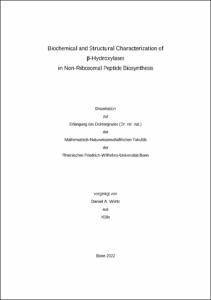Wirtz, Daniel A.: Biochemical and Structural Characterization of β-Hydroxylases in Non-Ribosomal Peptide Biosynthesis. - Bonn, 2022. - Dissertation, Rheinische Friedrich-Wilhelms-Universität Bonn.
Online-Ausgabe in bonndoc: https://nbn-resolving.org/urn:nbn:de:hbz:5-65384
Online-Ausgabe in bonndoc: https://nbn-resolving.org/urn:nbn:de:hbz:5-65384
@phdthesis{handle:20.500.11811/9590,
urn: https://nbn-resolving.org/urn:nbn:de:hbz:5-65384,
author = {{Daniel A. Wirtz}},
title = {Biochemical and Structural Characterization of β-Hydroxylases in Non-Ribosomal Peptide Biosynthesis},
school = {Rheinische Friedrich-Wilhelms-Universität Bonn},
year = 2022,
month = feb,
note = {Hydroxylases are essential in the biosynthesis of natural products by functionalization of building blocks, which derive from primary metabolism. They provide hydrophily for specific interactions or enable further derivatisation, which ultimately results in a natural product with outstanding activity. Hydroxylases, which are associated with non-ribosomal peptide synthetases (NRPS) contribute to the generation of diverse compounds with great significance for human society such as antibiotics or tumour therapeutics. Their wide-ranging importance is in stark contrast to the scarce knowledge about their structure, functionality, and substrate recognition. Hence, the trans acting hydroxylases in the biosynthetases of the non-ribosomal peptides hypeptin, lysobactin and FR900359 were investigated in this work.
Hypeptin is a cyclic octadepsipeptide from Lysobacter sp. with strong antibacterial activity against Gram-positive strains. The responsible biosynthetic gene cluster, (BGC) hyn encodes for two trans acting hydroxylases that are responsible for the β-hydroxylation of four amino acid residues. HynC belongs to the family of non-heme diiron monooxygenases (NHDM) and HynE is an iron- and α-ketoglutarate dependent hydroxylase. The characterization of HynC and HynE in vitro required the reconstitution of cognate NRPS modules, which were partly dependent on the MbtH-like protein, HynMLP that was not encoded within the hyn BGC. The successful reconstitution of HynC and HynE in vitro enabled determination of their substrate specificities, which were contradicting with the published stereoconfiguration of hypeptin. Finally, the reassigned configuration could be verified by in-depth NMR analyses.
The cyclic depsipeptide lysobactin shows a similar activity compared to hypeptin. The respective lyb BGC encodes for the interesting NHDM LybC, which is predicted to hydroxylate three structurally diverse amino acids. The cognate NRPS modules were successfully reconstituted in vitro, but no activity of the hydroxylase could be detected.
The selective and potent Gαq protein inhibitor FR9003559 (FR) is a cyclic octadepsipeptide with three β-hydroxylated leucine residues. During its biosynthesis, the monomodular NRPS FrsA, together with the NHDM synthesise the FR side chain N-propionylhydroxyleucine. Here, the biosynthesis of the side chain was reconstituted in vitro. To get a deeper insight into the mechanism of substrate recognition, the structure of FrsH was elucidated by crystallization trails and subsequent X-ray absorption spectroscopy. Additionally, the gene frsH was functionally substituted by hynC and lybC in the native producer Chromobacterium vaccinii, indicating a conserved structure of the NHDMs for substrate recognition. The gathered information were used for in silico docking studies to elucidate crucial residues for the interaction of FrsH and FrsA. Lastly, an assay was established to verify the outcome of the docking studies in vitro.},
url = {https://hdl.handle.net/20.500.11811/9590}
}
urn: https://nbn-resolving.org/urn:nbn:de:hbz:5-65384,
author = {{Daniel A. Wirtz}},
title = {Biochemical and Structural Characterization of β-Hydroxylases in Non-Ribosomal Peptide Biosynthesis},
school = {Rheinische Friedrich-Wilhelms-Universität Bonn},
year = 2022,
month = feb,
note = {Hydroxylases are essential in the biosynthesis of natural products by functionalization of building blocks, which derive from primary metabolism. They provide hydrophily for specific interactions or enable further derivatisation, which ultimately results in a natural product with outstanding activity. Hydroxylases, which are associated with non-ribosomal peptide synthetases (NRPS) contribute to the generation of diverse compounds with great significance for human society such as antibiotics or tumour therapeutics. Their wide-ranging importance is in stark contrast to the scarce knowledge about their structure, functionality, and substrate recognition. Hence, the trans acting hydroxylases in the biosynthetases of the non-ribosomal peptides hypeptin, lysobactin and FR900359 were investigated in this work.
Hypeptin is a cyclic octadepsipeptide from Lysobacter sp. with strong antibacterial activity against Gram-positive strains. The responsible biosynthetic gene cluster, (BGC) hyn encodes for two trans acting hydroxylases that are responsible for the β-hydroxylation of four amino acid residues. HynC belongs to the family of non-heme diiron monooxygenases (NHDM) and HynE is an iron- and α-ketoglutarate dependent hydroxylase. The characterization of HynC and HynE in vitro required the reconstitution of cognate NRPS modules, which were partly dependent on the MbtH-like protein, HynMLP that was not encoded within the hyn BGC. The successful reconstitution of HynC and HynE in vitro enabled determination of their substrate specificities, which were contradicting with the published stereoconfiguration of hypeptin. Finally, the reassigned configuration could be verified by in-depth NMR analyses.
The cyclic depsipeptide lysobactin shows a similar activity compared to hypeptin. The respective lyb BGC encodes for the interesting NHDM LybC, which is predicted to hydroxylate three structurally diverse amino acids. The cognate NRPS modules were successfully reconstituted in vitro, but no activity of the hydroxylase could be detected.
The selective and potent Gαq protein inhibitor FR9003559 (FR) is a cyclic octadepsipeptide with three β-hydroxylated leucine residues. During its biosynthesis, the monomodular NRPS FrsA, together with the NHDM synthesise the FR side chain N-propionylhydroxyleucine. Here, the biosynthesis of the side chain was reconstituted in vitro. To get a deeper insight into the mechanism of substrate recognition, the structure of FrsH was elucidated by crystallization trails and subsequent X-ray absorption spectroscopy. Additionally, the gene frsH was functionally substituted by hynC and lybC in the native producer Chromobacterium vaccinii, indicating a conserved structure of the NHDMs for substrate recognition. The gathered information were used for in silico docking studies to elucidate crucial residues for the interaction of FrsH and FrsA. Lastly, an assay was established to verify the outcome of the docking studies in vitro.},
url = {https://hdl.handle.net/20.500.11811/9590}
}






